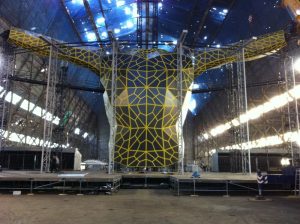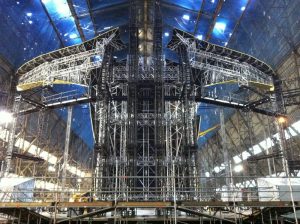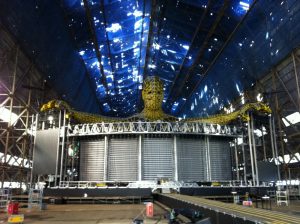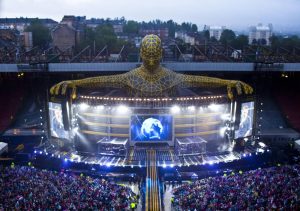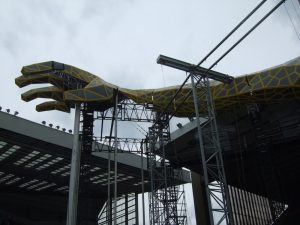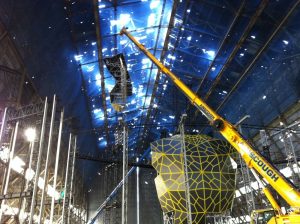Total Fabrication Manufacture ‘the Big Man’ For Take That Progress Tour. Take That – Ecce Homo
Named after their latest album, the eponymous Progress tour by Take That is breaking the boundaries of progress in more ways than one, “in simple terms we have constructed a giant man that spans the confines of the stadiums in which they play,” said Chris Cronin from Total Fabrications Ltd (TFL). “He is simply huge, so big that the main PA system hangs from his finger tips!” The ‘Big Man’ as he is known springs from the fertile imagination of Es Devlin, such is his size that Cronin knew immediately special measures would be required. “As soon as Chris Vaughan at The Production Office(TPO) confirmed us for the job the first thing I did was make a trip with Nigel Tranter (our project manager) and Malcolm Richards (TFL’s long serving Structural Engineer) to Stageco in Belgium. Even before we knew exactly how we would be building him we needed to determine how his form would interface between our structure and theirs.” The fixing mechanism is a vertical cone shape which self centres as each piece of the giant is lowered into place, “these are big cones, 100mm in diameter at their widest, solid machined steel; so as the crane lowers each major section it secures to the Stageco structure as it locates. That was always one of those unknowns, building something like this you are building a prototype, so until we got the first one to Cardington we’d never had the whole thing together and in place. Chris at TPO had mapped out a clear scheduling programme early on which helped enormously in keeping us all on track, so the time spent with Stageco and the effort of exhaustive structural modelling has all been well worthwhile. At Sunderland for example, the first Man was tested to the design limits during a major wind storm and not found wanting, and the second Man loaded into Manchester during a rainstorm of biblical proportions.” But just how do you build a man with a two hundred foot arm-span? “In detail, we adopted a design principal that the skeletal structure beneath the cladding form of the Man would be based on our Serious Medium Duty truss. Even though the truss lengths are for obvious reasons non-standard, that still gave us a known engineering building block to work with. The Man is sectional; each section is defined more by size and handling limitations than by form. The skin is triangular facets, large and small, so some sections might contain several triangles, some only one. These attach to the SMD truss by custom pairs of ‘blades’, vertical aluminium ladder type structures that follow the contour of the skin, each panel is captured by the blades in four places. One of TPO’s main concerns is logistics, assembly and transportation has to be demonstrably well thought out, fast and efficient; the big torso has large panels that are flat, so can be removed and easily packed for trucking; the fingers in contrast are dense in terms of triangle detail, and for reasons of time, need to stay together; but they still have to fit a truck. Ironically the smallest anatomical part becomes the largest piece to truck.”
Devlin’s design required that the fingers also support the main PA system so the structural demands were hugely increased. “They proved an extraordinary challenge” Cronin confirmed, “what appears as a Line Array dangling beneath his index finger is a load weighing two and a half tons that needs to transfer back seven metres to the Stageco tower. For this we developed special trussing concealed within the hand; it actually looks more impressive when the hand is unclad, well to an engineer like me it does.” Luckily Devlin had drawn to such a scale that the hands could comfortably accommodate the special trussing, “had the PA been much heavier then he’d have needed outsized hands; even so with the structures we built, and conforming to all necessary safety factors, we calculated to within 85% of load capacity.”
Fabricating his skin presented different challenges. “As you might imagine, we had to build two Men so they could leap-frog from venue to venue. Chris Vaughan gave us a twelve week build time in total; pretty audacious under the circumstances, but he proved spot on; we built the first Man in seven weeks the second in five. We employed a hundred people in all, drawing on All Alliance crew (a professional stage crew in Birmingham) and a team of eight scenic artists. We also rented an extra 20,000 sq/ft of warehouse space for partial assembly. His skin is 9mm plywood; to set the fixing blades in place and fit skin panels we assembled the relevant SMD truss structures in various ways. His head for example we built on its side, and then erected scaffold to get welders and fabricators up to his features; his cheek and temple would be approximately 20 feet above the factory floor. Then when complete, we removed the skin panels, rolled his head over, and repeated the routine for the other side of his face. Painting was time consuming; each panel has an intumescent coating for fire-proofing, then two coats of scenic artwork.”
Like all such unique projects, new lessons are learned. “The key to a project like this is anticipating eventualities. The first Big Man was in every sense a prototype, that’s why building the second one took significantly less time; you learn so much. But we also know that some prototype learning would apply in the field. As soon as the touring crew got to grapple with Big Man they’d inevitably saw ways to improve. So we built those refinements into Man two before he shipped to Manchester; and then took Man one from Sunderland and modified him in time for the Cardiff load-in. On a personal level, having watched Nigel, Malcolm, and all the guys work so hard and so well, I salute them all. Ecce Homo* as Pontius Pilate once said.”
*Translates as ‘Behold the Man’ said by Pontius Pilate at the trial of Christ

